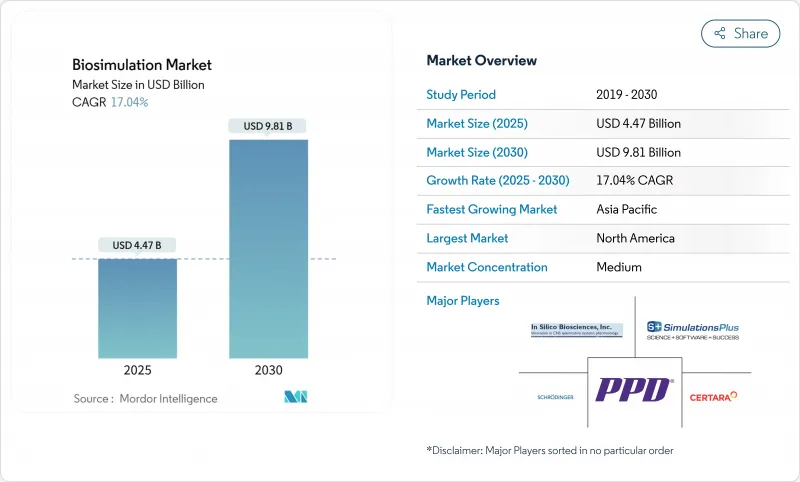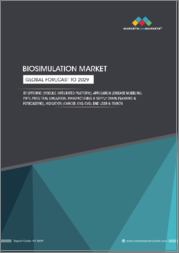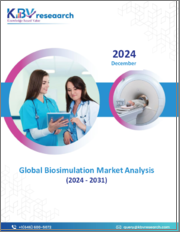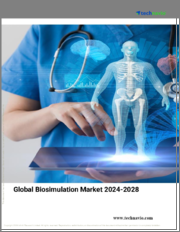
|
시장보고서
상품코드
1836626
바이오시뮬레이션 시장 : 점유율 분석, 산업 동향, 통계, 성장 예측(2025-2030년)Biosimulation - Market Share Analysis, Industry Trends & Statistics, Growth Forecasts (2025 - 2030) |
||||||
바이오시뮬레이션 시장 규모는 2025년에 44억 7,000만 달러, 예측 기간 중(2025-2030년) CAGR은 17.04%를 나타내고, 2030년에는 98억 1,000만 달러에 달할 것으로 예측됩니다.

강력한 성장의 배경은 제약업계가 급등하는 연구개발비를 억제하기 위해 인실리코 모델링을 이용하게 된 것, 규제 당국이 모델 정보에 기초한 의약품 개발을 공식적으로 승인한 것, 클라우드 기반 고성능 컴퓨팅의 급속한 진보가 있습니다. 또한 FDA의 정량적 의학 센터 오브 엑설런스, ICH M15 가이드라인의 최종 결정, 동물 실험 요건을 삭감하기 위한 가상 트윈 연구의 이용 확대 사용으로 탄력을 받고 있습니다. 기업의 IT 예산 확대, 인공지능 통합, 정밀의료 파이프라인 확대가 수요를 더욱 강화하는 한편, 벤더는 적당히 세분화되어 분석의 깊이, 치료 영역의 전문지식, 규제에 대한 정통도로 차별화를 도모할 수 있습니다.
세계 바이오시뮬레이션 시장 동향과 통찰
건강 관리 분야의 IT 예산 증가
생명 과학 분야의 CIO를 대상으로 한 조사에 따르면 2024년에는 과반수의 기업이 기술 예산을 증액하고, 4분의 1의 기업이 인공지능 프로젝트를 우선하고 있습니다. 예산 증가는 PBPK, QSP, AI 알고리즘을 통합한 바이오시뮬레이션 플랫폼에 대한 수요 증가로 이어집니다. 화이자와 노보놀 디스크는 클라우드 네이티브 모델링에 대한 투자와 관련된 측정 가능한 비용 절감을 공개적으로 보고하고 있어 광범위한 배포를 위한 비즈니스 사례를 강화하고 있습니다. 또한 클라우드 인프라 업그레이드도 가속화되어 세계 분산 팀 간의 광범위한 가상 트윈 연구 및 실시간 협업을 가능하게 합니다. 이 추세는 중기적으로 바이오시뮬레이션 시장이 두 자릿수 성장을 뒷받침합니다.
규제 당국에 의한 바이오시뮬레이션 플랫폼의 채택 확대
규제 추진력이 중요한 임계점에 도달했습니다. FDA는 QSP 기반 신청이 1.4년마다 두 배로 증가하고 있음을 지적하며, 상설 MIDD 페어 미팅 프로그램은 정량 모델에 대한 체계적인 조언을 제공합니다. 2024년에 최종화된 ICH M15 가이드라인은 모델 정보를 기반으로 하는 의약품 개발에 대한 국제적인 기대를 조화시켜 스폰서에 대한 불확실성을 완화합니다. EMA와 PMDA는 상세한 PBPK 지침을 발표했으며, 단일클론항체에 대해서는 동물 실험 대신 시뮬레이션 데이터를 받아들이는 기관이 늘고 있습니다. 이러한 공식 승인은 신청이 성공할 때마다 신뢰를 높이고 더 많은 후원자가 바이오시뮬레이션을 개발 계획에 통합하는 피드백 루프를 형성합니다.
임상의와 임상시험팀에서 낮은 인지도
많은 임상 책임 의사는 정량적 모델링 출력에 익숙하지 않기 때문에 가상의 지식을 프로토콜 디자인과 의사 결정에 완전히 통합 할 수 없습니다. 교육 커리큘럼은 첨단 파마 코메트릭스 모듈을 포함하지 않는 경우가 많으며, 업무 직원들은 전통적인 방식을 우선시하는 엄격한 타임라인에 직면하고 있습니다. 기업은 사내 아카데미나 e-러닝 모듈로 대응하고 있지만, 치료 영역이나 지역에 따라 그 도입에는 아직 차이가 있습니다. 디지털 인프라가 늦어지면서 현지 규제 당국이 ICH M15를 참조하기 시작한 신흥 시장에서는 그 격차가 가장 큽니다. 실용적인 노하우가 보급될 때까지, 일부 스폰서는 바이오시뮬레이션의 가능성을 충분히 활용할 수 없을 것입니다.
보고서에서 분석된 기타 촉진요인 및 억제요인
- 의약품 개발 비용 상승
- 클라우드 기반 고성능 컴퓨팅에 의한 시뮬레이션 TCO 삭감
- 숙련된 PBPK/QSP 모델러 부족
부문 분석
소프트웨어 솔루션의 2024년 매출은 67.87%에 달했으며, 시각화, 검증 및 규제 당국에 대한 보고서를 간소화하는 통합 모델링 환경이 선호되고 있음을 반영합니다. Certara의 Phoenix 릴리스와 Dassault Systemes의 BIOVIA 업그레이드는 화합물 스크리닝을 가속화하는 AI 모듈의 임베디드 경쟁을 뒷받침합니다. 바이오시뮬레이션 시장에서는 PBPK와 QSP 엔진에 직관적인 대시보드와 풍부한 화합물 라이브러리를 결합한 벤더가 계속 주목을 받고 있습니다. 서비스의 절대 금액은 작고 스폰서는 워크플로우를 사용자 정의하고 복잡한 출력을 해석하기 위해 컨설팅 전문 지식을 요구하기 때문에 서비스는 꾸준히 성장하고 있습니다.
서비스는 현재 틈새 시장이지만 실시간 바이오센서 데이터가 만성 질환 관리를 위한 디지털 트윈 데이터에 직접 공급되기 때문에 2030년까지 연평균 복합 성장률(CAGR)이 18.41%가 될 것으로 예측되고 있습니다. 이 확대로 바이오시뮬레이션 시장은 의약품 개발에서 임상 의사 결정 지원으로 확대됩니다. 서비스 제공업체는 센서 스트림과 QSP 모델의 통합이라는 복잡한 작업으로부터 이익을 얻을 수 있습니다. 플랫폼 소프트웨어와 종합적인 권고 서비스를 결합한 공급업체는 후기 단계 프로젝트에서 더 높은 점유율을 얻을 수 있는 입장에 있습니다.
주요 제약 회사는 고급 사내 데이터센터를 유지하고 있기 때문에 소유권 기반 도입이 여전히 47.45%의 수익을 차지하고 있습니다. 그러나 구독 서비스는 기업이 탄력적인 컴퓨팅과 낮은 자본 지출을 평가하기 때문에 CAGR 19.19%로 성장하고 있습니다. 바이오시뮬레이션 시장은 규제 대상 워크로드가 Good Practice 가이드라인의 인증을 받은 검증된 클라우드 환경으로 이동한다는 생명과학 분야의 큰 동향을 반영합니다. 지속적인 알고리즘 업데이트와 컴플라이언스 기능의 통합은 IT 전문가가 없는 중소규모 스폰서에게 매력적입니다.
보안 및 데이터 주권은 특히 독점적 인 단일 클론 항체 서열 및 지역 프라이버시 규칙의 대상이되는 임상시험 데이터를 다룰 때 일부 기업이 사내 구축 환경에 남아있는 이유입니다. 따라서 민감한 워크로드는 방화벽 내부에 배치되고 버스트 컴퓨팅은 클라우드로 전송되는 하이브리드 모델이 존재합니다. 플랫폼 제공업체는 환경 간을 원활하게 이동하는 컨테이너화된 배포를 지원하며 두 환경에서 동일한 검증 문서를 보장합니다. 전자 기록 관리에 관한 규제 당국의 명확화가 진행되면 피보탈 스터디 모델의 클라우드 이용이 더욱 진행될 것으로 보입니다.
지역별 분석
북미는 2024년 매출 점유율에서 44.56%를 차지하며 FDA의 모델 정보 개발에 대한 적극적인 자세와 현지 벤처기업의 자금조달에 지지를 받고 있습니다. 유럽은 EMA의 광범위한 PBPK 지침, 클라우드의 안전한 도입을 촉진하는 견고한 데이터 프라이버시 방법, 소프트웨어 공급업체 및 연구 병원과의 강력한 산업 협력에 힘쓰고 있습니다. 두 지역 모두 복잡한 생물 제제에 QSP를 조기에 채택하는 기업이 많습니다.
아시아태평양은 규제 하모나이제이션과 바이오시밀러 파이프라인 확대로 혜택을 받았으며 CAGR로 가장 빠른 23.49%를 기록했습니다. 일본의 의약품 의료기기 종합기구(PMDA)는 2024년 초까지 35품목의 바이오시밀러 의약품을 승인했지만, 그 중 몇 품목은 모델링을 활용하여 임상 데이터 세트의 간략화를 정당화하고 있습니다. 중국 의약품 혁신을 위한 다년간 계획에는 지역 센터를 설립하는 세계 플랫폼 제공업체가 모여 있으며, 인도의 신규 생명공학 회랑에는 비용 효율적인 모델 구축을 위한 용량이 추가되었습니다. 인건비 감소와 데이터 사이언스자 증가로 현지 기업은 바이오시뮬레이션 전용 센터를 운영할 수 있게 되어 지역 독립성이 강화되고 있습니다.
라틴아메리카, 중동 및 아프리카의 현재 점유율은 작지만 다국적 스폰서가 다양한 집단으로 가상 조사 방법을 확대함에 따라 관심이 가속화되고 있습니다. 기술이전 프로그램에 의해 현지의 노하우가 축적되어 클라우드 인프라의 전개에 의해 진입 장벽이 낮아지고 있습니다. 시간이 지남에 따라 보다 광범위한 실제 데이터를 이용할 수 있게 되면, 이러한 충분한 서비스를 받지 못한 시장에서도 바이오시뮬레이션의 가능성이 극대화될 것입니다.
기타 혜택 :
- 엑셀 형식 시장 예측(ME) 시트
- 3개월간의 애널리스트 서포트
목차
제1장 서론
- 조사의 전제조건과 시장 정의
- 조사 범위
제2장 조사 방법
제3장 주요 요약
제4장 시장 상황
- 시장 개요
- 시장 성장 촉진요인
- 헬스케어 분야의 IT 예산 증가
- 규제 당국에 의한 바이오시뮬레이션 플랫폼의 채택 확대
- 의약품 개발 비용 상승
- 클라우드 기반의 고성능 컴퓨팅이 시뮬레이션의 TCO를 삭감
- FDA MIDD 프로그램의 주류는 모델 베이스 신청
- 실세계 데이터 주도의 「버추얼 트윈」시험의 확대
- 시장 성장 억제요인
- 임상의와 임상시험팀에서 낮은 인지도
- 숙련된 PBPK/QSP 모델러의 부족
- 세계의 데이터 포맷과 모델 밸리데이션의 표준의 부족
- AI 생성 모델에 관한 규제상의 불확실성
- Porter's Five Forces 분석
- 신규 참가업체의 위협
- 구매자의 협상력
- 공급기업의 협상력
- 대체품의 위협
- 경쟁 기업간 경쟁 관계
제5장 시장 규모·성장 예측(단위 : 달러)
- 제품별
- 소프트웨어
- 서비스별
- 딜리버리 모델별
- 구독
- On-Premise
- 용도별
- 전임상 및 임상 의약품 개발
- 약물 발견과 리드 최적화
- 정밀의료 및 동반진단 디자인
- 최종 사용자별
- 제약 및 바이오테크놀러지 기업
- 수탁연구기관
- 학술기관 및 연구기관
- 지역별
- 북미
- 미국
- 캐나다
- 멕시코
- 유럽
- 독일
- 영국
- 프랑스
- 이탈리아
- 스페인
- 기타 유럽
- 아시아태평양
- 중국
- 일본
- 인도
- 호주
- 한국
- 기타 아시아태평양
- 중동 및 아프리카
- GCC
- 남아프리카
- 기타 중동 및 아프리카
- 남미
- 브라질
- 아르헨티나
- 기타 남미
- 북미
제6장 경쟁 구도
- 시장 집중도
- 시장 점유율 분석
- 기업 프로파일
- Certara
- Dassault Systemes(BIOVIA)
- Simulations Plus
- Schrodinger
- Genedata
- Leadscope
- Entelos
- In Silico Biosciences
- Pharmaceutical Product Development
- Compugen
- Applied BioMath
- GNS Healthcare
- VeriSIM Life
- Insilico Medicine
- Syntekabio
- Simcyp
- Garuda Therapeutics
- Ansys(subsidiary MEDINI)
- Cadence Design Systems
- EMD Serono
제7장 시장 기회와 전망
SHW 25.10.28The Biosimulation Market size is estimated at USD 4.47 billion in 2025, and is expected to reach USD 9.81 billion by 2030, at a CAGR of 17.04% during the forecast period (2025-2030).

Strong growth stems from the pharmaceutical sector's rising use of in-silico modeling to curb escalating R&D expenses, from regulators' formal endorsement of model-informed drug development, and from rapid progress in cloud-delivered high-performance computing. Adoption also receives momentum from the FDA's Quantitative Medicine Center of Excellence, the finalized ICH M15 guideline, and the broadening use of virtual twin studies to reduce animal testing requirements fda.gov. Wider corporate IT budgets, artificial intelligence integration, and expanding precision-medicine pipelines further reinforce demand, while moderate fragmentation allows vendors to differentiate on analytics depth, therapeutic-area expertise, and regulatory familiarity.
Global Biosimulation Market Trends and Insights
Increasing Healthcare-Sector IT Budgets
Life-sciences CIO surveys show that a majority of firms raised technology allocations in 2024, with one quarter prioritizing artificial-intelligence projects. Larger budgets translate into stronger demand for integrated biosimulation platforms that merge PBPK, QSP, and AI algorithms. Pfizer and Novo Nordisk publicly report measurable cost savings tied to cloud-native modeling investments, reinforcing the business case for broader rollouts. Elevated spending also accelerates cloud infrastructure upgrades that permit extensive virtual twin studies and real-time collaboration among globally dispersed teams. The trend supports sustained double-digit growth for the biosimulation market over the medium term.
Growing Adoption of Biosimulation Platforms by Regulators
Regulatory momentum has reached a critical threshold. The FDA notes that QSP-based submissions now double every 1.4 years, while its permanent MIDD-paired-meeting program offers structured advice on quantitative models. The ICH M15 guideline, finalized in 2024, harmonizes international expectations for model-informed drug development and reduces uncertainty for sponsors. The EMA and PMDA publish detailed PBPK guidance, and agencies increasingly accept simulation data in lieu of animal studies for monoclonal antibodies. This official endorsement creates a feedback loop: each successful filing builds confidence, prompting still more sponsors to embed biosimulation into development plans.
Limited Awareness Among Clinicians & Trial Teams
Many trial investigators remain unfamiliar with quantitative modeling outputs, hindering full integration of virtual insights into protocol design and decision making. Educational curricula often lack advanced pharmacometrics modules, and operational staff face tight timelines that favor traditional practices. Companies respond with internal academies and e-learning modules, yet adoption still varies by therapeutic area and geography. The gap is widest in emerging markets where digital infrastructure lags and local regulators are only beginning to reference ICH M15. Until practical know-how spreads, some sponsors will under-utilize biosimulation's potential.
Other drivers and restraints analyzed in the detailed report include:
- Escalating Drug-Development Costs
- Cloud-Based High-Performance Computing Cuts Simulation TCO
- Shortage of Skilled PBPK/QSP Modelers
For complete list of drivers and restraints, kindly check the Table Of Contents.
Segment Analysis
Software solutions held 67.87% revenue in 2024, reflecting the preference for integrated modeling environments that streamline visualization, verification, and regulatory reporting. Certara's Phoenix release and Dassault Systemes' BIOVIA upgrades underscore a race to embed AI modules that speed compound screening. The biosimulation market continues to reward vendors that couple PBPK and QSP engines with intuitive dashboards and extensive compound libraries. Services, while smaller in absolute value, grow steadily as sponsors seek consulting expertise to customize workflows and interpret complex outputs.
Services, though niche today, are projected to post an 18.41% CAGR by 2030 as real-time biosensor data feed directly into digital twins for chronic-disease management. This expansion broadens the biosimulation market beyond drug development into clinical decision support. Services providers benefit from the complexity of integrating sensor streams with QSP models, a task that demands both domain knowledge and data-engineering skills. Vendors that combine platform software with wraparound advisory offerings are positioned to capture higher share of wallet in late-stage projects.
Ownership-based deployments still account for 47.45% revenue because large pharmaceutical companies maintain sophisticated internal data centers. However, subscription services grow at 19.19% CAGR as firms value elastic compute and lower capital outlay. The biosimulation market reflects a larger life-sciences trend in which regulated workloads shift to validated cloud environments certified for Good Practice guidelines. Continuous algorithm updates and embedded compliance features appeal to small and mid-sized sponsors that lack specialist IT staff.
Security and data-sovereignty remain reasons for some enterprises to remain on-premise, especially when handling proprietary monoclonal-antibody sequences or trial data subject to regional privacy rules. Hybrid models therefore persist, with sensitive workloads staying behind the firewall and burst compute sent to the cloud. Platform providers respond with containerized deployments that move seamlessly between environments, ensuring identical validation documentation in either setting. Increased clarity from regulators regarding electronic-records controls will further unlock cloud use for pivotal-study models.
The Biosimulation Market Report Segments the Industry Into by Product (Software, Services), Delivery Model (Subscription, Ownership / On-Premise), Application (Preclinical and Clinical Drug Development, and More), by End User (Pharmaceutical and Biotechnology Companies, and More), and Geography (North America, Europe, Asia-Pacific, Middle-East and Africa, South America). The Market Forecasts are Provided in Terms of Value (USD).
Geography Analysis
North America dominated with 44.56% revenue share in 2024, supported by the FDA's proactive stance on model-informed development and deep local venture funding. Europe follows, fueled by the EMA's extensive PBPK guidance, robust data-privacy laws that encourage secure cloud adoption, and strong industrial ties between software vendors and research hospitals. Both regions host many early adopters of QSP for complex biologics.
Asia-Pacific registers the fastest 23.49% CAGR, benefiting from regulatory harmonization and an expanding biosimilar pipeline. Japan's PMDA approved 35 biosimilar products by early 2024, several of which leveraged modeling to justify abbreviated clinical datasets. China's multi-year plan for pharmaceutical innovation has attracted global platform providers to establish regional centers, while India's emerging biotech corridor adds capacity for cost-efficient model building. Lower labor costs and a growing pool of data scientists enable local firms to operate dedicated biosimulation centers, reinforcing regional independence.
Latin America, the Middle East, and Africa contribute smaller shares today but display accelerating interest as multinational sponsors extend virtual-study methodology to diverse populations. Technology-transfer programs seed local know-how, and cloud infrastructure rollouts lower entry barriers. Over time, broader real-world-data availability will unlock the full potential of biosimulation in these underserved markets.
- Certara
- Dassault Systemes (BIOVIA)
- Simulations Plus
- Schrodinger
- Genedata
- Leadscope
- Entelos
- In Silico Biosciences
- Pharmaceutical Product Development
- Compugen
- Applied BioMath
- GNS Healthcare
- VeriSIM Life
- Insilico Medicine
- Syntekabio
- Simcyp
- Garuda Therapeutics
- Ansys (subsidiary MEDINI)
- Cadence Design Systems
- EMD Serono
Additional Benefits:
- The market estimate (ME) sheet in Excel format
- 3 months of analyst support
TABLE OF CONTENTS
1 Introduction
- 1.1 Study Assumptions & Market Definition
- 1.2 Scope of the Study
2 Research Methodology
3 Executive Summary
4 Market Landscape
- 4.1 Market Overview
- 4.2 Market Drivers
- 4.2.1 Increasing Healthcare-Sector IT Budgets
- 4.2.2 Growing Adoption of Biosimulation Platforms by Regulators
- 4.2.3 Escalating Drug-Development Costs
- 4.2.4 Cloud-Based High-Performance Computing Cuts Simulation TCO
- 4.2.5 FDA MIDD Program Mainstreams Model-Based Submissions
- 4.2.6 Expansion of Real-World-Data-Driven 'Virtual-Twin' Studies
- 4.3 Market Restraints
- 4.3.1 Limited Awareness Among Clinicians & Trial Teams
- 4.3.2 Shortage of Skilled PBPK/QSP Modelers
- 4.3.3 Lack of Global Data-Format & Model-Validation Standards
- 4.3.4 Regulatory Uncertainty Around AI-Generated Models
- 4.4 Porter's Five Forces Analysis
- 4.4.1 Threat of New Entrants
- 4.4.2 Bargaining Power of Buyers
- 4.4.3 Bargaining Power of Suppliers
- 4.4.4 Threat of Substitutes
- 4.4.5 Competitive Rivalry
5 Market Size & Growth Forecasts (Value in USD)
- 5.1 By Product
- 5.1.1 Software
- 5.1.2 Services
- 5.2 By Delivery Model
- 5.2.1 Subscription
- 5.2.2 Ownership / On-premise
- 5.3 By Application
- 5.3.1 Pre-clinical & Clinical Drug Development
- 5.3.2 Drug Discovery & Lead Optimization
- 5.3.3 Precision-medicine & Companion-diagnostics Design
- 5.4 By End User
- 5.4.1 Pharmaceutical & Biotechnology Companies
- 5.4.2 Contract Research Organizations
- 5.4.3 Academic & Research Institutes
- 5.5 By Geography
- 5.5.1 North America
- 5.5.1.1 United States
- 5.5.1.2 Canada
- 5.5.1.3 Mexico
- 5.5.2 Europe
- 5.5.2.1 Germany
- 5.5.2.2 United Kingdom
- 5.5.2.3 France
- 5.5.2.4 Italy
- 5.5.2.5 Spain
- 5.5.2.6 Rest of Europe
- 5.5.3 Asia-Pacific
- 5.5.3.1 China
- 5.5.3.2 Japan
- 5.5.3.3 India
- 5.5.3.4 Australia
- 5.5.3.5 South Korea
- 5.5.3.6 Rest of Asia-Pacific
- 5.5.4 Middle East & Africa
- 5.5.4.1 GCC
- 5.5.4.2 South Africa
- 5.5.4.3 Rest of Middle East & Africa
- 5.5.5 South America
- 5.5.5.1 Brazil
- 5.5.5.2 Argentina
- 5.5.5.3 Rest of South America
- 5.5.1 North America
6 Competitive Landscape
- 6.1 Market Concentration
- 6.2 Market Share Analysis
- 6.3 Company Profiles (includes Global level Overview, Market level overview, Core Segments, Financials as available, Strategic Information, Market Rank/Share for key companies, Products & Services, and Recent Developments)
- 6.3.1 Certara
- 6.3.2 Dassault Systemes (BIOVIA)
- 6.3.3 Simulations Plus
- 6.3.4 Schrodinger
- 6.3.5 Genedata
- 6.3.6 Leadscope
- 6.3.7 Entelos
- 6.3.8 In Silico Biosciences
- 6.3.9 Pharmaceutical Product Development
- 6.3.10 Compugen
- 6.3.11 Applied BioMath
- 6.3.12 GNS Healthcare
- 6.3.13 VeriSIM Life
- 6.3.14 Insilico Medicine
- 6.3.15 Syntekabio
- 6.3.16 Simcyp
- 6.3.17 Garuda Therapeutics
- 6.3.18 Ansys (subsidiary MEDINI)
- 6.3.19 Cadence Design Systems
- 6.3.20 EMD Serono
7 Market Opportunities & Future Outlook
- 7.1 White-space & Unmet-need Assessment

















